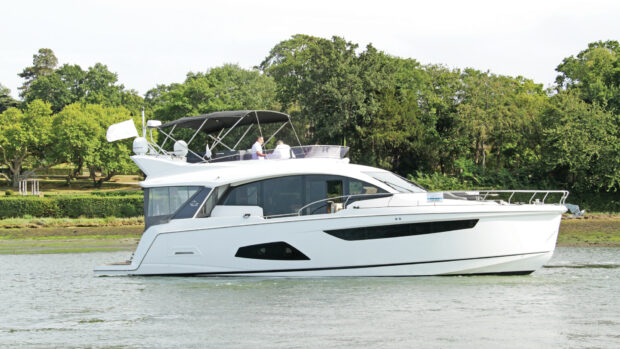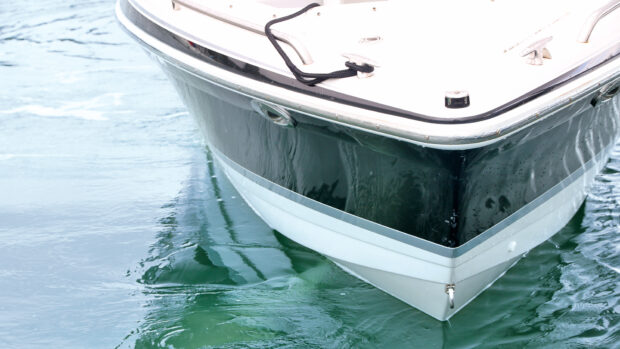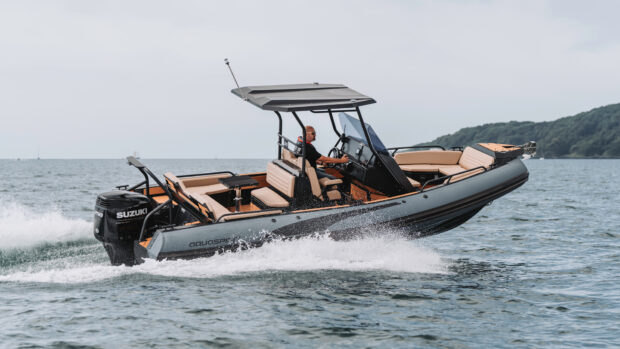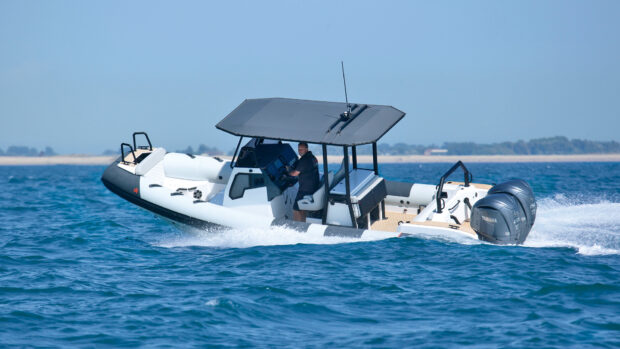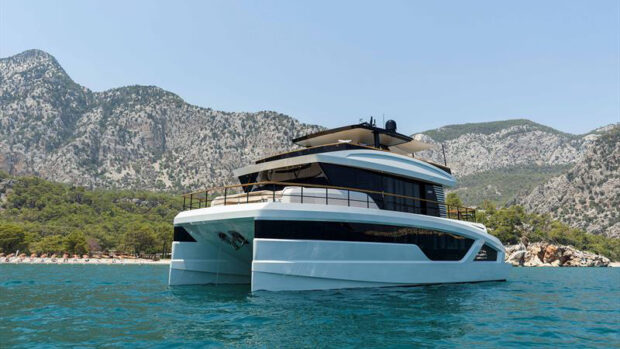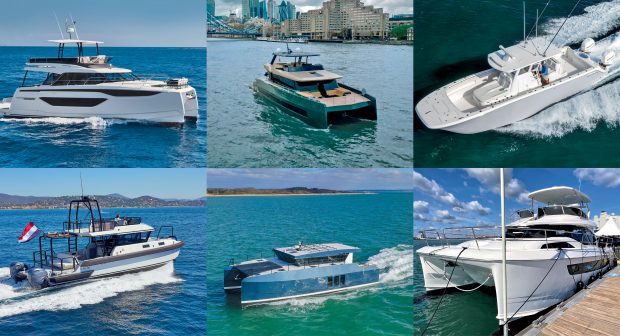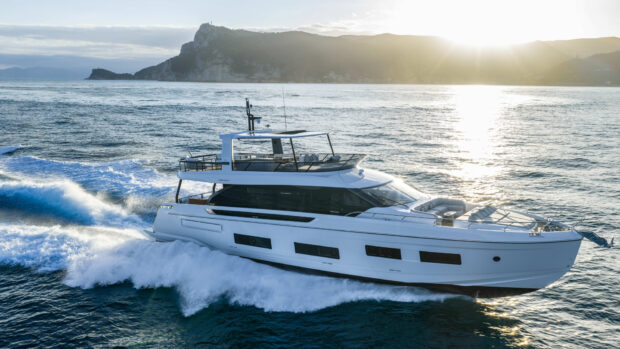Bored with the ordinary? Rustler’s first-ever powerboat, the Rustler 41, might be just the tonic you need…
Having forged its reputation over the last 50-60 years through the creation of top-notch ocean-going sailing yachts, Rustler’s first-ever motorboat, the Rustler 41, has finally arrived. And we say finally because it’s been quite a few years in the making.
The project originally began in response to customer requests for an easy, reliable seagoing motor yacht that would be simpler to handle and more stable to cruise on than a sailing yacht. But exactly how that would look remained open to question for a long spell while Rustler director, Adrian Jones, consulted with his customers, his in-house staff, and a range of yacht designers.
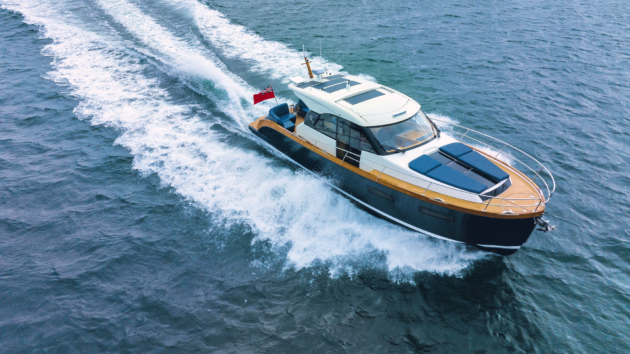
Rustler’s first-ever motorboat has finally arrived
Critically, he wanted to create something that would cater not for how we imagine we might use our boats, but for how we actually use them. As a small-scale semi-custom British builder, there was of course plenty of discussion about going semi-displacement like Dale or Duchy – but after a conversation with Tony Castro, it was decided that a planing hull with some extra beam would make better sense.
After all, volume is useful on a modestly sized cruiser; and once you’re up and running, the potential firmness of a planing vessel’s relatively bulbous forward hull form tends to be mitigated by virtue of the fact that it’s skimming over (rather than ploughing through) the water’s surface. And so in spite of its slow-grown heritage in Rustler’s artisan West Country workshop, the 41 became that rarest of things – a classical gentleman’s launch with an authentic planing hull.
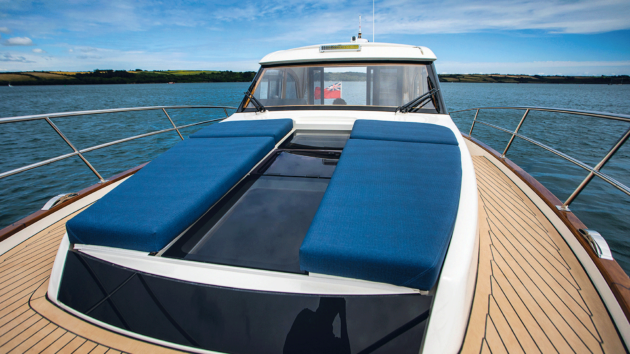
It’s not the most comfortable sunbed but it’s great for light down below
Free-thinking space
As you approach the new 41 from the aft end, you move from a fixed swim platform through a central transom door to a large, safe, sociable cockpit with a pair of handy side gates. There are L-shaped seating modules in each quarter and both operate as lovely big storage lockers.
These spaces are easily accessed by means of large aft doors with long rams and spectacularly over-engineered stainless steel hinges; and they’re fastidiously lined, too, enabling you to run your hands into all sorts of hidden recesses without the slightest hint of a troublesome fibreglass shard.
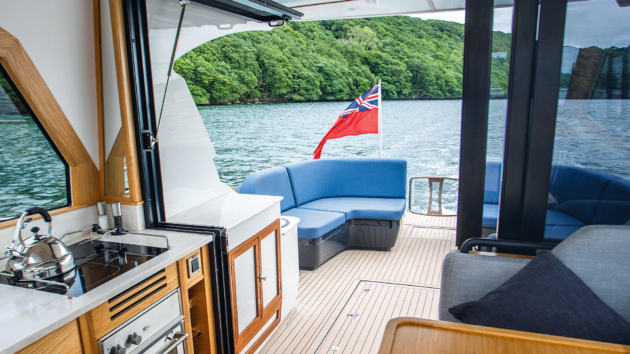
The galley extends out to join up with the cockpit’s starboard cabinet
Ahead of these stern modules, a relaxed chaise-longue-style seat looks aft from a delightfully sheltered position in the lee of the superstructure on the port side. And on the starboard side sits a cabinet containing a champagne bucket and a Scanstrut compressor for inflating a tender or paddleboard.
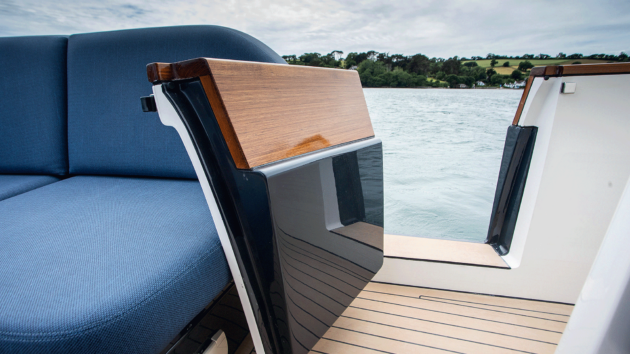
Quality of fixtures and fittings is strong throughout
You can have a wine rack instead of the pump but because the cabinet is at the same level as the interior worktop, it means that when you flip up the hinged starboard window, it becomes a very natural extension of the galley.
In the centre of the deck, a hatch provides great engine bay access, thanks to a large aperture, a built-in step and a central run of checkerplate. But you can tell that Rustler has no interest in crowbarring more than two cabins into this boat.
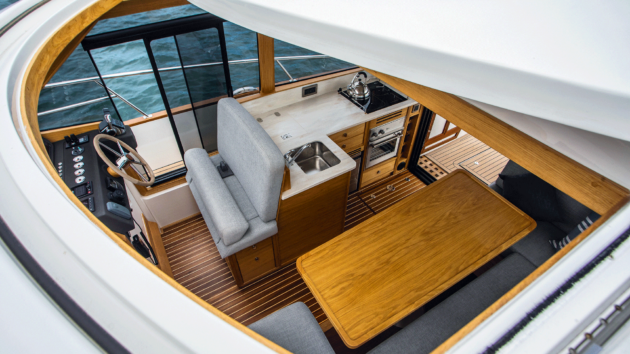
It’s clear from the start that this is a straightforward boat for single-handed skippers
On the contrary, it believes you go boating as a couple and the engineering spaces illustrate that. The twin Yanmar 4.5L V8 370s, for instance, are positioned a good way forward on straight shafts.
That’s great for weight distribution and it also frees up the space for a generator aft, a pair of longitudinal 600-litre fuel tanks and a fuel-polishing system. But the electrics are conspicuous by their absence and that’s because, in spite of its modest length, the 41 features a separate engineering room.
Tucked away on the starboard side, with access through a door in the bathroom’s aft bulkhead, this actively ventilated space is an engineer’s dream. Removed from the heat, space constraints and humidity of the engine bay, the sheer clarity of thought behind the routing, the labelling, the access and the environment is way superior to the vast majority of leisure boat installations.
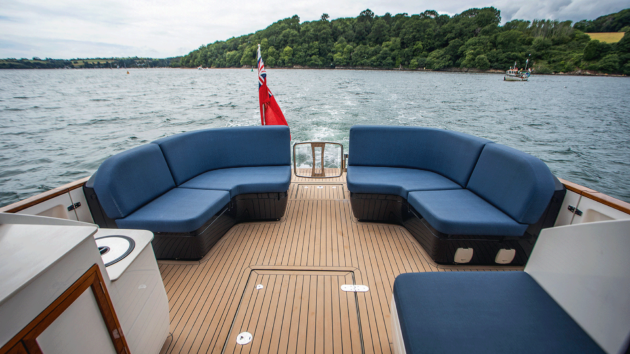
Twin side decks, twin side gates and a transom walkway mean excellent freedom of movement
As intimated, that does limit the space available for cabins, but before we get to that, it’s worth taking a walk forward because, like the engineering room, the joinery here is a bit of a treat.
The teak capping rails, which sweep unbroken from bow to stern, are a case in point. Having visited the factory, we’ve seen how much care Rustler’s joinery department lavishes on each element of the boat and it certainly shows in elements like that.
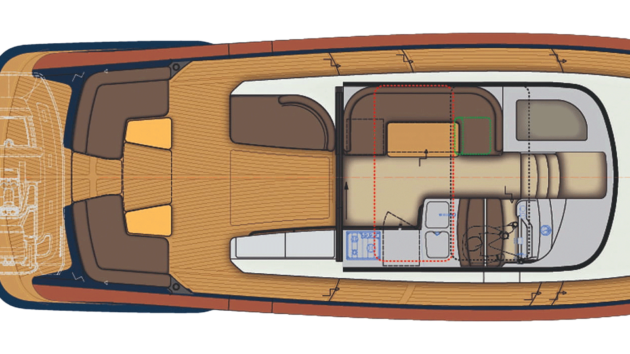
The port lounger is nicely tucked up in the lee of the wheelhouse
But given how much teak is used in the external trim, and how much pale oak in the internal cabinetry, it’s good to see that the external deck is lined with an artificial low-maintenance alternative instead.
Article continues below…

Dale 45 Classic tour: A new and improved gentleman’s boat

Hardy 50DS tour: £2M Passage-Making Monster
The saloon
The layout of the internal saloon is all pretty straightforward. It comprises a slender L-shaped starboard galley and a raised port dinette. The galley comes with an induction hob, an oven, a fridge, a sink and a wine rack, plus a second drop-in fridge, built entirely in-house and sunken into the Corian worktop with a simple switch that also allows you to use it as a freezer.
Ahead of this are the twin helm seats, where the skipper gets a grandstand view thanks to a big curved one-piece screen. That was something that Castro insisted on in the design stages and while it pays big dividends in terms of forward visibility, it does mean that the oak-lined mullions on either side are a shade fat.
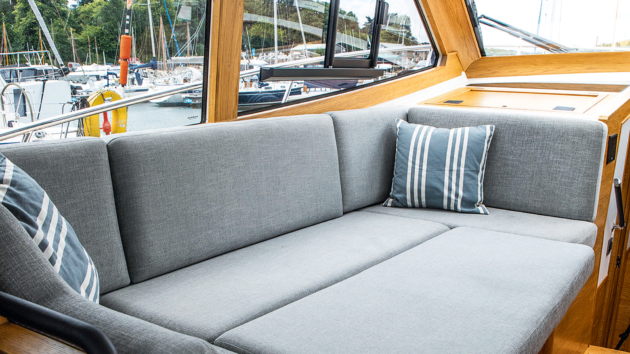
The convertible dinette is big enough for a 6ft 3in adult to bed down for the night
Over to port, the dinette operates as an occasional double berth with enough space for a 6ft 3in adult to stretch out at night. While it uses a fixed, rather than reversible, forward backrest, it’s relatively practical too.
A set of drawers beneath the aft section houses some Silwy mugs, which secure to their trays magnetically, but you can of course opt for ranks of bespoke oak trays with individual crockery slots instead.
Further forward, beyond the aft-facing seat, there‘s also a small chart table built into the dashtop with room beneath the lid for your paper charts and nav instruments. And on the underside of the dinette, adding light and air to volume, is a small portlight for extra comfort in the transverse guest cabin.
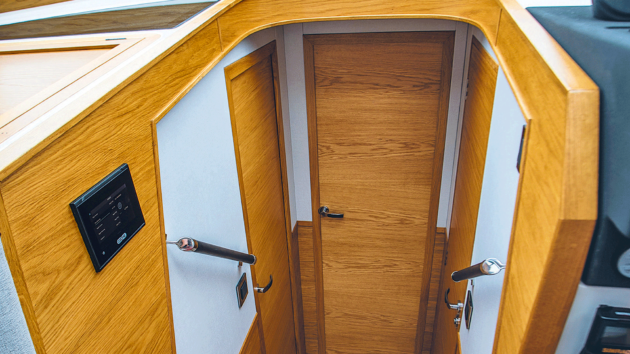
Entrance to the cabins
The cabins
When you head down below, Rustler’s modest two-cabin one-bathroom layout makes perfect sense. The guest cabin gets a good hull window plus a panel in the port dashtop to bring extra natural light into the lofty changing section.
It also provides lots of space for a pair of single beds that slide together to form a quick-rig double. And while the raked screen brings plenty of light down to the central atrium, the bow cabin also benefits from a pair of decent hull windows and triple glass skylights that run the entire length of the bow’s sunbed.
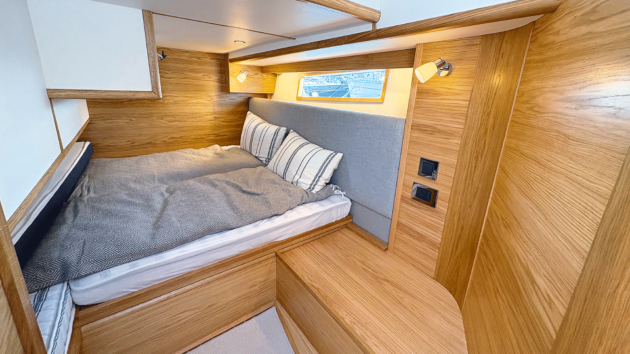
The guest beds slide apart to create a pair of transverse singles
But if the flow of light is very strong, the flow of space feels equally good. Solid curved edging to the bulkheads, the cupboards and the cabinets looks superb and it also opens up the lower deck, enabling you to move freely without the prospect of clattering your elbows.
Curved cupboard doors also mean better access to the storage spaces and the use of vertical vent slots in a playful wave pattern at the base of these doors helps keep the air fresh while adding a pleasing stylistic flourish.
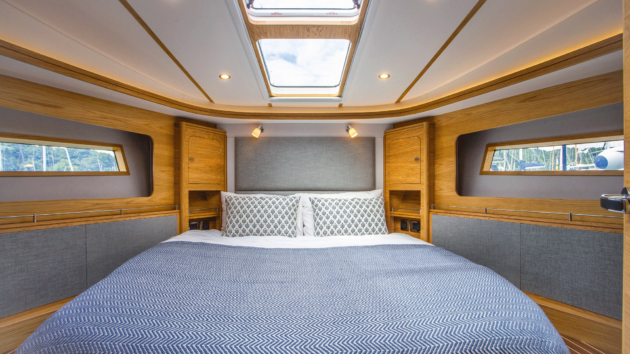
There’s excellent forward breadth plus good height, even at the head end of the bed
The bathroom is also impressive. It uses a proper full-height door for easy stoop-free access. And once you’re in, it provides a generous separate shower, excellent headroom and a very satisfying quality of fit-out. The fluted glass sink is augmented with oak cabinetry and the shower is equipped with a teak seat.
The loo could do with shunting a couple of inches outboard so you’re not rubbing shoulders with the inboard bulkhead but that aside, it’s a very strong space.
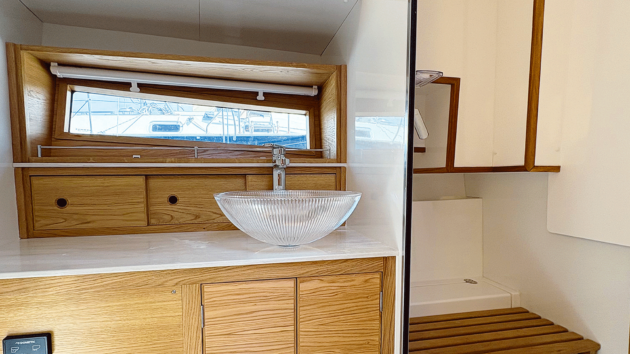
The nicely scaled and well finished day heads provides direct access to the engineering room
The skipper’s mate
It’s clear from the start that this is an easy boat for single-handed operation. The skipper gets a side door and a sliding port window for easy communication. There are also substantially raised steel rails that come halfway up your thigh as you make your way toward the bow, as well as gates on both sides for easy pontoon access.
The symmetrical layout means you get walkaround decks of the same scale because, as Adrian rightly points out, “you’re equally large whichever side of the boat you choose to use”. And you even get four, rather than two, cleats at the bow to make things simpler when anchoring or tying off with a spring.
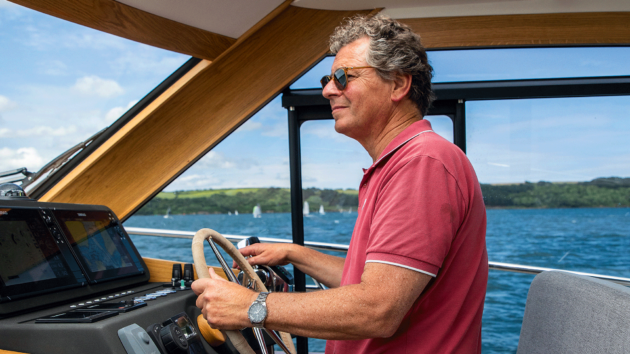
Deepset glass delivers outstanding views on the beam
As for the driver’s position, that gets a gorgeous Italian wheel, which was independently sourced by the owner, and comes with a lovely fibrous suede wrap. But while that was a great choice, the inclusion of four non-standard analogue dials seems less productive, as it shifts the Simrad and Yanmar displays to port, filling the space that would have been used for a pair of cupholders.
There’s also a row of bespoke laser-etched buttons to supplement the C-Zone digital switching, plus a set of proportional bow and stern thrusters. These sit precisely where the owner wanted them on the righthand side but again, for our money, they would be better off taking the place of the tabs on the left so you can operate them while your right hand engages the throttles.
It would also be good to see the overhead sunroof get a glass panel for extra light and visibility. And there’s a fair bit of glare from the dash top – in particular from the fibreglass angle beneath the lower screen rim, so it would be good to see the low-glare fabric of the helm station extended further forward to put a stop to that.
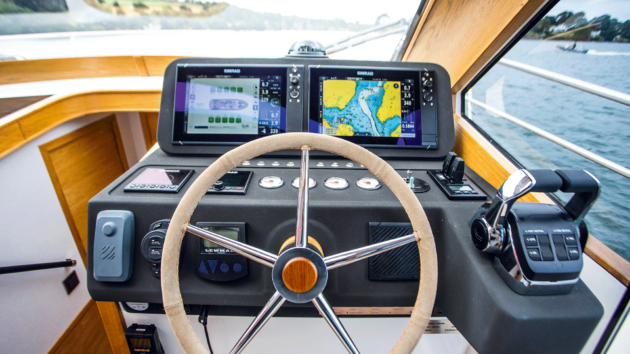
The owner sourced his own leather wheel from Italy
Even so, with those 4.5L 8LV 370s positioned a good way forward and operating through straight shafts, alongside a hull designed to treat you kindly at displacement speeds, as well as at higher revs, this is a very friendly driver’s boat.
It runs dead straight when you’re pootling along at six knots and when you push on to more diverting speeds, the transition is delightfully flat. Even without any input from the tabs, we’re able to plane with a good attitude at 15 knots and, in spite of westerlies gusting to around 20 knots, the windage feels equally benign. There’s no haste or urgency here – just the faintest notch of tab to really fine-tune the running attitude.
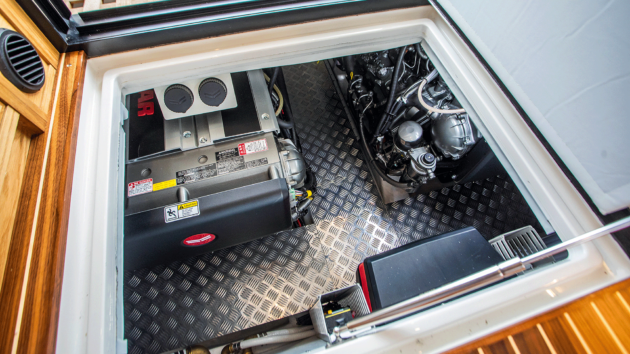
Engines on long shafts prioritise balance over cabin space
Happily, the fuel flow broadly mirrors the ease of that driving experience. At everything from 12 to 24 knots, we’re seeing a good flat line from 3.6 to 4.3 litres per nautical mile for a range from 220 to 270nm.
And the way the hull deals with the choppy wind-whipped swells is also very appealing. It feels very solid and well built but always with sufficient lightness to respond with dexterity and quickwittedness to your input at the helm.
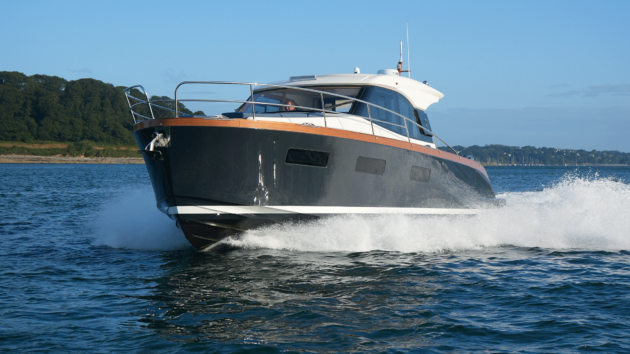
A skipper’s side door, port window and big side decks make everything very easy
There’s some useful bow flare too so the bulk of the water is kicked well wide. And lovely lofty windows on both sides do great things for your view on the beam, even when turning hard to port.
In short, this boat combines classical looks, an artisan fit-out, seagoing manners and simple driving fun to very appealing effect. In the future, outboards will apparently be an option – and given the importance of the American market, that’s only to be expected. But for now, let’s simply rejoice in how beautifully this graceful new powerboat performs.
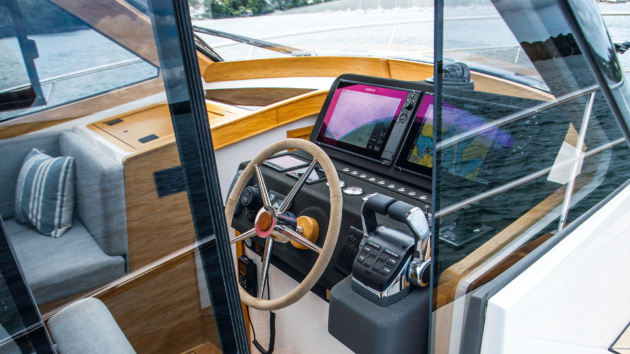
The one-piece screen requires chunky mullions
 If you enjoyed this….
If you enjoyed this….
Motor Boat & Yachting is the world’s leading magazine for Motoryacht enthusiasts. Every month we have inspirational adventures and practical features to help you realise your sailing dreams, as well as tests and news of all the latest motorboats.
Plus you’ll get our quarterly Custom Yachting supplement where we share the last on offer in the superyacht world and at the luxury end of the market.
Build your knowledge with a subscription delivered to your door. See our latest offers and save at least 30% off the cover price.
Note: We may earn a commission when you buy through links on our site, at no extra cost to you. This doesn’t affect our editorial independence.
Price as reviewed:
£1,180,000.00 As tested
Verdict
This is obviously not your average 40ft cruiser. On the outside, it looks very different in a restrained, self-confident semi-classical kind of way. And on the inside, its management of light and space creates a very natural and unforced flow that is all too rare in a market that often strives to squeeze maximum features out of limited proportions. That is, of course, a double-edged sword, because like most brave and distinctive powerboats, the charming new 41 is unlikely to achieve the same box-ticking breadth of appeal as its more mainstream competitors. But after years of hard work bringing this first-ever powerboat to market, Adrian seems keen not to overthink it. Rustler is simply “a small boat builder working hard to make the most beautiful boats possible”. And while it’s easy to get bogged down in features, options and wishlists, it’s very tough to argue with that.
Details
LOA: 41 ft 0in (12.50m)
Beam: 13ft 4in (4.00)
Draft: 2ft 4in (0.64m)
Displacement: 11,000kg (light)
Fuel capacity: 1,200 litres
Water capacity: 300 litres
Engines: 2 x Yanmar 4.5L V8 8LV 370hp diesels
Top speed: 35 knots with test engine
Consumption: 76 lph at 20 knots
Range: 252 miles at 20 knots
Noise: 72dB(A) at 20 knots
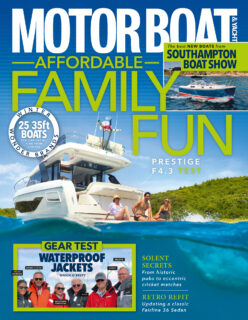

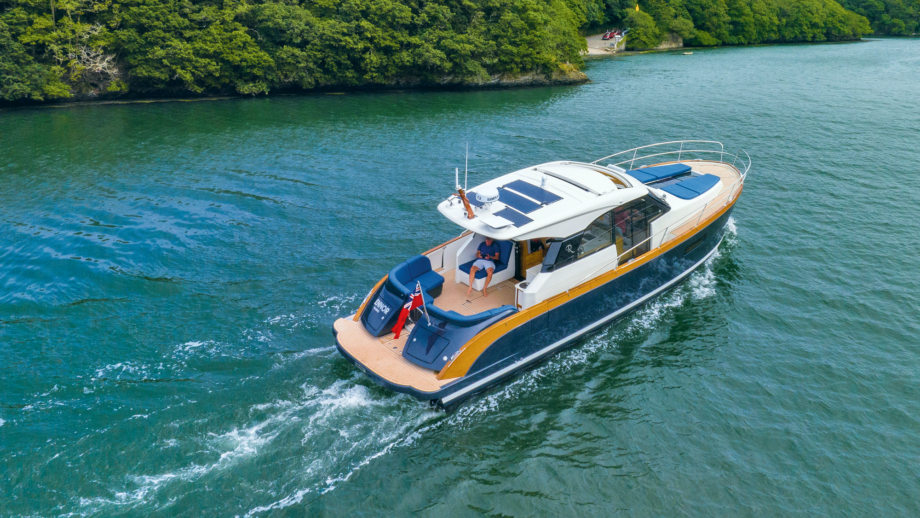
 If you enjoyed this….
If you enjoyed this….